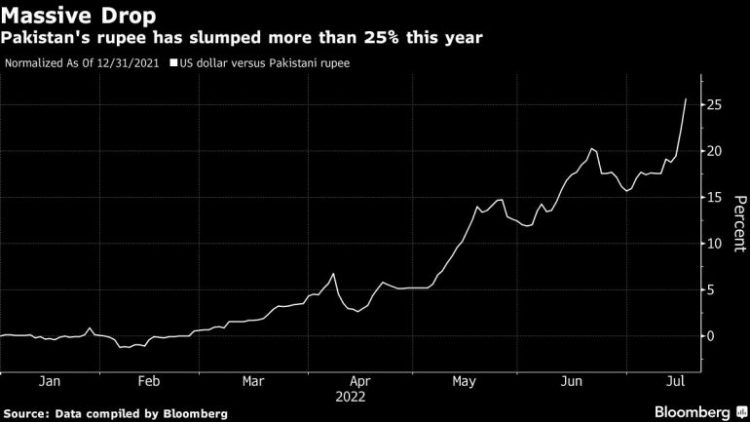Finance Minister Miftah Ismail said the panic was due to political turmoil and not over economic fundamentals.
Pakistan’s finance minister has blamed the rupee’s slide on political turmoil, saying he expects market jitters over the currency’s sharp decline to subside soon.
“The rupee downturn is not due to economic fundamentals,” Miftah Ismail told the Reuters news agency on Wednesday. “The panic is primarily due to political turmoil, which will subside in a few days.”
The rupee fell 2 percent on Monday, and 3 percent on Tuesday, despite last week’s staff level agreement reached with the International Monetary Fund (IMF) that would pave the way for a disbursement of $1.17bn under resumed payments of a bailout package.
On Wednesday morning, the rupee was trading at 225 per dollar, having ended Tuesday at 221.99 after Fitch Ratings revised its outlook for Pakistan’s sovereign debt from stable to negative – though it affirmed the Long-Term Foreign-Currency (LTFC) and Issuer Default Rating (IDR) at “B-“.
Emerging-market currencies are feeling the heat as the hawkish Federal Reserve lures capital towards the United States. The panic in the South Asian market also comes from escalating risks after former premier Imran Khan’s by-election win added to concern over the country’s bailout deal with the IMF, which it needs to avoid a default.
“There is panic in the market, I fear it [the rupee] will go down further,” Zafar Paracha, secretary-general of the Exchange Companies of Pakistan, a foreign exchange association, told Reuters earlier on Wednesday.
Paracha said he did not see any reason for the depreciation in the rupee other than possible IMF pre-conditions. Neither the government nor the IMF has said anything about the need for any further depreciation of the currency, though Pakistan recently adopted a market-based exchange rate under advice from the lender under the economic reforms agenda.
The finance minister said imports, which put pressure on the rupee, have been curbed and the current account deficit has been controlled in the first 18 days of June.
Pressure on the rupee will ease moving forward, he said, adding that Pakistan had already worked out sources to meet its financing gaps.
“The recent movement in the rupee is a feature of a market-determined exchange rate system,” the State Bank of Pakistan said in a series of Twitter posts late on Tuesday night.
Pakistan is grappling with fast depleting foreign currency reserves, a declining rupee and widening fiscal and current account deficits, and the rupee has lost 18 percent of its value since December 21.
Reserves have fallen to as low as $9.8bn, hardly enough to pay for 45 days of imports.
Pakistan has also passed through another bout of political instability, with the government of Prime Minister Shehbaz Sharif taking over from then-premier Imran Khan, who was removed in April. Khan has been pressing the current government to call early elections, holding a series of political gatherings across the country.
On Tuesday, sovereign dollar bonds issued by Pakistan suffered sharp losses to record lows after Fitch’s move, while the Pakistan Stock Exchange’s KSE100 Index fell 2.36 percent.
Source by www.aljazeera.com






























